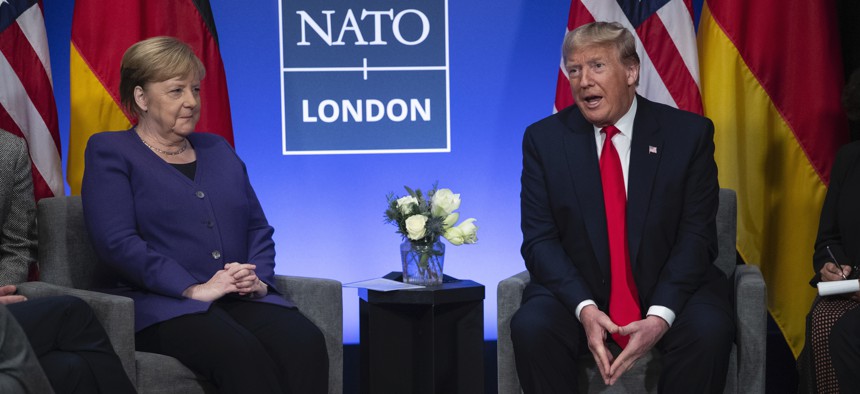
President Donald Trump speaks during a meeting with German Chancellor Angela Merkel during the NATO summit at The Grove, Wednesday, Dec. 4, 2019, in Watford, England. President Donald Trump is calling Canadian Prime Minister Justin Trudeau “two-faced” aft AP Photo/Evan Vucci
Critics, Allies Wonder What Trump’s Trying to Achieve with Troop Cuts
One GOP lawmaker worries “it’s going to hurt U.S. strategic interests more than it’s going to punish Germany.”
President Donald Trump’s decision to withdraw 9,500 U.S. troops from Germany has alarmed Republican lawmakers and former defense officials who question whether there is a solid strategy behind the 30 percent reduction — even as they support Trump’s purported goal of urging Germany to spend more on its own defense.
Dozens of GOP lawmakers have come out against the announcement, publicly voicing concerns that the drawdown would embolden Russia, hamstring the defense of NATO’s eastern members, and reduce the Pentagon’s ability to flow U.S. forces through Germany to bases around the world.
Privately, they have even more pointed questions about the analysis underpinning the decision. According to a House Foreign Affairs Committee aide, top Republican Rep. Mike McCaul’s “primary concern that it’s going to hurt U.S. strategic interests more than it’s going to punish Germany.”
Right now, roughly 34,000 U.S. troops are permanently stationed in Germany, including at the headquarters for U.S. Africa Command and U.S. Europe Command in Stuttgart. The bulk of the force is there to be quickly marshaled to vulnerable eastern-flank nations if Russia attacks.
Cutting those troops, critics say, raises the risk to those countries, but probably won’t hurt Germany, which is much farther from the Russian border and is no longer seen as the “front line” of a potential conflict.
“At the strategic level, the only people who are being hurt are the U.S. and countries like Estonia, Latvia, Lithuania, Poland, who depend on U.S. capability if there’s a crisis — and they’re all 2 percenters,” said Ben Hodges, a retired 3-star who commanded all U.S. Army forces in Europe. Hodges was referring to the 2 percent of GDP that all NATO countries are supposed to spend on defense by 2024. (Germany says it hopes to reach that benchmark by 2031.)
“They’re being punished and we’re screwing ourselves — but the Germans are feeling no pain,” he said.
Hodges, like the dozens of GOP lawmakers protesting the move, said Germany can and should contribute more to its national defense. The question is whether the loss of 9,500 American troops will do anything to change the political calculus in Berlin — and at what cost to the United States.
Trump, in announcing the cut, said he was penalizing Berlin for being “delinquent” in its defense spending.
"So we're protecting Germany and they're delinquent. That doesn't make sense,” the president told White House reporters on June 15. “So I said, we're going to bring down the count to 25,000 soldiers."
Then, for almost a full week, defense officials were silent on the details of the plan — or even whether they had presented options to the president. On Sunday, National Security Advisor Robert O’Brien penned an op-ed in the Wall Street Journal that cast the decision as part of a strategic effort to retool U.S. deployments to be more “forward and expeditionary” in order to counter China and Russia. “Several thousand” of the troops could be reassigned to other countries in Europe, O’Brien wrote, while other “thousands” may be sent to the Indopacific region.
But the devil is in the details and, so far, key congressional leaders and even some Pentagon officials who work on force posture in the region are in the dark. Why 9,000 troops — and which 9,000 — remains an open question. According to O’Brien, Defense Secretary Mark Esper and Joint Chiefs Chairman Gen. Mark Milley are “working diligently to provide the president with options to carry out this plan.” Some officials, caught by surprise by the move, suggested that it was a political decision pushed by Trump’s former ambassador to Germany, Richard Grenell.
“They’re all scrambling right now because none of them knew this was coming. This was not the result of long-term strategic analysis or the interagency process,” Hodges said, in an interview from Germany.
James Jay Carafano, a defense analyst at the conservative Heritage Foundation, suggested that the announcement could be the opening salvo in an attempt to push Germany towards hitting its 2 percent goal. “To me, it’s maybe ‘what do you have to lose?’” Carafano said, noting that the U.S.-German relationship is already fraught — in part because Germany is beset by tense domestic politics that have complicated U.S. efforts to push it towards spending more.
“The reality is Germany does have obligations to the security of the alliance and those obligations are in their vital interest, even if it’s not about protecting the people of Germany,” Carafano said. “Do I think that the threat of the U.S. pullout will change German popular opinion? Will it get a response from the German government that maybe causes some rethinking? I don’t know. It might.”
But he also raised questions about the strategic utility of moving 9,500 troops out of Germany — troops that are all potentially critical in Europe, where the footprint is much smaller, but a drop in the bucket compared to the already-massive U.S. presence in the Indo-Pacific region. (Trump has also repeatedly expressed interest in severely limiting the American force presence there, too.)
“You can’t rob Peter to pay Paul,” Carafano said. “Even though Russia is the weaker power, you can’t have a destabilized Western Europe. You can’t fix your China problem by creating a Western Europe security problem.”
“Nobody can tell me what that means — how 10,000 [additional troops] in the Pacfiic would dramatically improve your posture.”
O’Brien, in his Journal op-ed, said that the practice of “garrisoning large numbers of troops with their families on massive bases” is now “obsolete.”
“Modern warfare is increasingly expeditionary and requires platforms with extended range, flexibility and endurance,” he wrote. “While air bases and logistics hubs remain important, the Cold War-style garrisoning of troops makes less military and fiscal sense than it did in the 1970s.”
That assertion has been met with skepticism both on and off Capitol Hill. There is growing momentum on the Hill to include a provision in the annual defense policy bill to limit Trump’s ability to cut troops in Germany below a certain level, according to conversations with aides on both the House and Senate Armed Services Committees. Hodges, meanwhile, pushed back on O’Brien’s characterization of the U.S. force presence in Germany as “massive.”
“Gimme a break, massive bases?” he said. “34,000 [troops] would not fill up but a third of the Michigan football stadium. That’s for all of Europe and Africa,” Hodges said. “That’s what we’re talking about. Put it in the proper context.”
Correction: A previous version of this article misidentified retired Lt. Gen. Ben Hodges as former commander of all U.S. military forces in Europe. He was commander of U.S. Army Europe.
